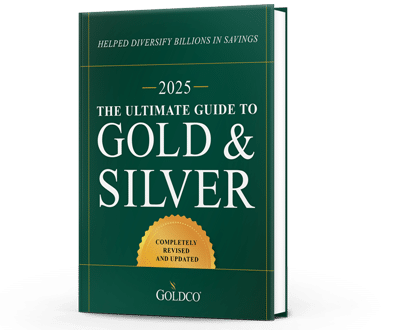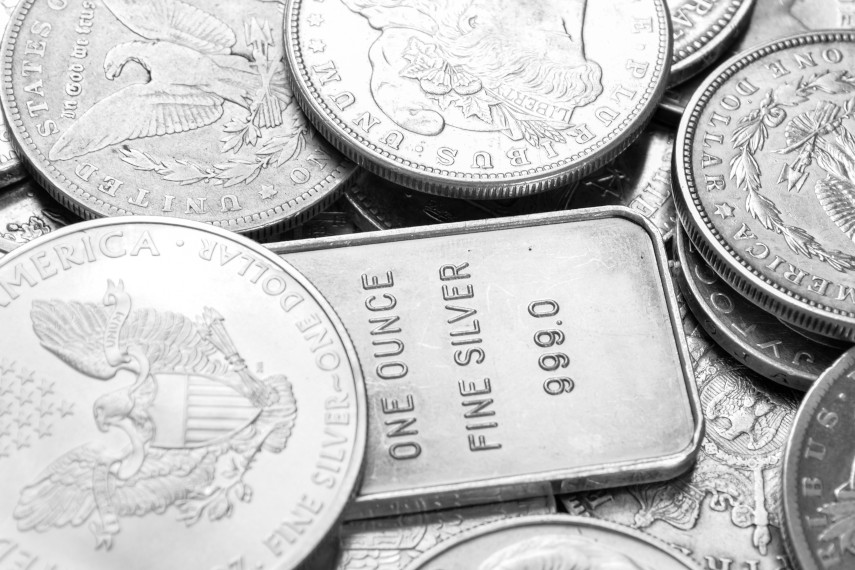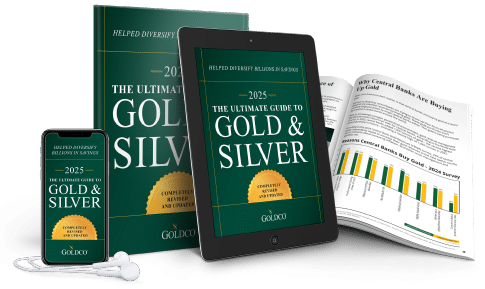
Unease about the future of the US economy is growing, as a weakening labor market and persistent inflation are helping fuel fears of a potential recession. With the spectre of 2008 at the back of many people’s minds, protecting finances has become an urgent priority today.
Safe haven buying has increased as these fears have become pronounced, and gold, a traditional safe haven, has become one of the beneficiaries of this safe haven buying.
The gold price has set numerous record highs this year, and many predict the gold price to keep on growing. One way that people are helping to add gold to their portfolios is through gold IRAs.
Gold IRAs have become more and more popular in recent years as more Americans are learning that they can actually own physical gold coins or gold bars within an IRA.
But for people who may only have a workplace 401(k), or whose only experience with IRAs is through conventional IRA accounts with financial brokerages, they may be wondering how to set up a gold IRA account.
Thankfully, the process of setting up a gold IRA is relatively simple. Read on to learn more about what gold IRAs are and how to set up a gold IRA account.
Self-Directed IRAs vs. Traditional IRAs
Gold IRAs are a type of self-directed IRA, which is why they are able to acquire alternative assets such as gold.
Comparing self-directed IRAs to Traditional IRAs is a bit of a misnomer, because many self-directed IRAs are Traditional IRAs, meaning that they’re funded with pre-tax dollars. But for many people, Traditional IRAs are the primary type of IRA against which other types of IRAs are compared.
| Feature |
Self-Directed IRA
|
Traditional IRA
|
| Custodian |
Self-directed IRAs are offered by a smaller number of custodians who specialize in administering self-directed IRA assets |
Traditional IRAs are offered by numerous custodians and financial institutions |
| Account Control |
You own and control the account |
You own and control the account |
| Asset Types |
Alternative assets, including real estate, cryptocurrencies, precious metals, and private equity |
Normally limited to conventional financial assets such as stocks, bonds, mutual funds and exchange-traded funds (ETFs) |
| Contribution Limits |
$7,000 annual contribution limit for 2025 ($8,000 for those over age 50); no limit for rollovers from other retirement accounts into an IRA |
$7,000 annual contribution limit for 2025 ($8,000 for those over age 50); no limit for rollovers from other retirement accounts into an IRA |
| Annual Fees |
Fees vary according to what types of assets you hold in your IRA and what your IRA custodian may charge for administrative costs |
Many custodians offer accounts with no fees to open and hold an account; fees may be charged for certain trades, and most funds charge an expense ratio for management and administration |
What Is a Gold IRA?
Gold IRAs are a type of self-directed IRA which hold physical gold coins or gold bars. These assets are administered by a self-directed IRA custodian and stored at a bullion depository.
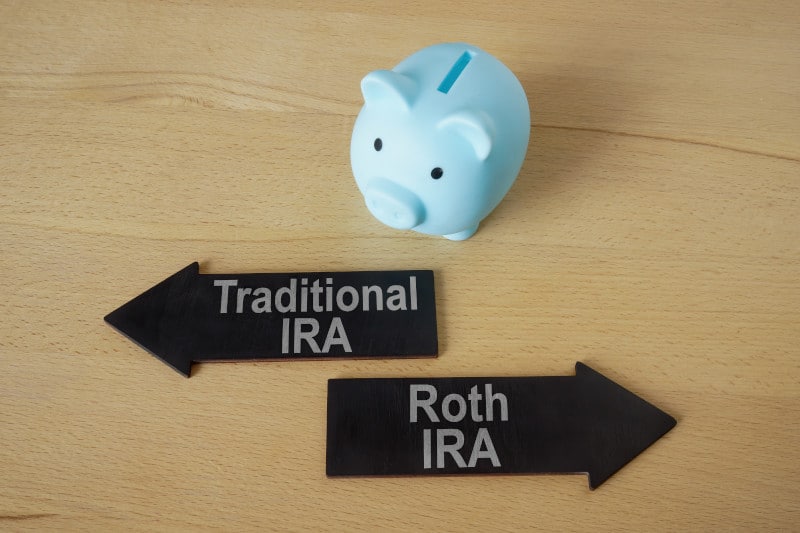
Types of Gold IRAs
For most people, there are two types of gold IRAs you’ll be looking at, a Traditional gold IRA and a Roth gold IRA.
|
Traditional Gold IRA
|
Roth Gold IRA
|
- Purchases assets with pre-tax dollars
- Assets grow tax-deferred, with no annual taxation on capital gains, interest, or dividends
- Distributions are taxed at ordinary income tax rates
- Anyone with earned income can make annual contributions to a Traditional IRA
- Required minimum distributions (RMDs) must be taken once you reach age 73
- Any distributions before age 59½ may be subject to a 10% penalty in addition to any taxes due
|
- Purchases assets with post-tax dollars
- Assets grow tax-free, with no annual taxation on capital gains, interest, or dividends
- Qualified distributions can be made tax-free
- Annual contributions to Roth IRAs can only be made by those below certain income limits
- No RMDs are required for the original account owner
- Contributions to a Roth IRA can be withdrawn tax- and penalty-free at any time
|
Additionally, there is such a thing as a SEP gold IRA. SEP gold IRAs have a distinct advantage in that their annual contribution limits are far higher, up to 25% of your annual compensation or $70,000 for 2025.
In order to open a SEP gold IRA, however, you have to have or be eligible to have a SEP (Simplified Employee Pension) IRA, which is not common. SEP IRAs are a special type of IRA in which employers only, not employees, make contributions.
While any business of any size, even self-employed people, can open a SEP IRA, they’re not terribly common. Still, if you have a SEP IRA or are a business owner looking to start a SEP IRA, a SEP gold IRA is a possible option.
How to Fund a Gold IRA
There are two primary ways to fund a gold IRA, through annual contributions or through rollovers and transfers.
| Funding Method |
Annual Contributions
|
Rollovers & Transfers
|
| Pros |
- Contributions to Traditional IRAs can be tax-deductible, depending on your income
- Ease of contributions; don’t have to worry about tax consequences of rollovers, Roth IRA conversions, etc.
|
- No limit to how much you can roll over, allowing you to start an account with much more money than through annual contributions
- Can start a rollover IRA with no earned income
|
| Cons |
- Lower contribution limits ($7,000 in 2025; $8,000 for those over age 50) make it difficult to build up a large account
- Smaller account size means that fees could eat up a larger percentage of your assets
- Income restrictions on contributions to Roth IRAs or tax deductibility of contributions to Traditional IRAs
|
- One rollover per year rule limits the amount of financial maneuvering you can do
- Have to worry about potential tax consequences, particularly if doing an indirect rollover
|
| Common Benefits |
- Tax-deferred growth; your assets aren’t subject to annual taxation on capital gains, interest, or dividends
- Taxes are only paid at distribution for Traditional IRAs
- Qualified distributions from Roth IRAs can be made tax-free
|

Pros and Cons of Owning Gold
|
Advantages of Owning Gold
|
Disadvantages of Owning Gold
|
- Gold Is a Safe Haven Asset
- Gold Can Help Hedge Against Inflation
- Gold Can Help Diversify Your Portfolio
- Gold Markets Are Highly Liquid
|
- No Income Generation
- Storage and Insurance Costs
- Risk of Counterfeiting
|
Advantage 1: Gold Is a Safe Haven Asset
Gold has helped serve as a safe haven asset for centuries. Even today, gold is one of the primary assets people trust as a safe haven asset, and the gold price often rises as a result of that safe haven buying activity.
Advantage 2: Gold Can Help Hedge Against inflation
Gold is also often viewed as an inflation hedge, as it tends to maintain its value over time despite devaluation of currencies. The US dollar, for instance, has lost 88% of its purchasing power since 1971, while gold has gained over 9,000% in value.
Gold also has a history of performing well during periods of high inflation, with the gold price posting annualized growth of over 30% per year over the course of the 1970s.
Advantage 3: Gold Can Help Diversify Your Portfolio
Gold has traditionally been seen as an asset that can help diversify portfolios. One of the goals of portfolio diversification is to diversify into assets that have low correlation with each other so that if one part of your portfolio loses value, other parts might not follow suit.
Gold helps fill that role because it has a low correlation with stocks, bonds, and other conventional financial instruments.
Advantage 4: Gold Markets Are Highly Liquid
Gold markets operate around the world nearly 24/7, ensuring a ready supply of and demand for gold, as well as steady and transparent pricing.
Disadvantage 1: No Income Generation
Gold doesn’t pay dividends or interest, which limits your gains to those made solely from increases in the gold price.
Disadvantage 2: Storage and Insurance Costs
When you buy gold coins and gold bars, you’ll have to store them somewhere and, depending on how much gold you buy, you may also want to consider an insurance policy. That can cost you money, which is something you need to factor into your financial planning.
Disadvantage 3: Risk of Counterfeiting
Counterfeiting gold coins and gold bars has been a perennial problem, and with the gold price continuing to set all-time highs, makes gold counterfeiting a potentially lucrative proposition for counterfeiters. Goldco works directly with mints around the world to source our gold coins, ensuring that the gold you buy from us is 100% authentic.
Common Questions About Gold IRAs
What kinds of precious metals can I hold in my gold IRA?: You’re not limited to just holding gold coins or gold bars in your gold IRA. You can also hold silver, platinum, and palladium coins and bars in your gold IRA, as these precious metals are also eligible for IRA acquisition.
What kinds of gold coins are IRA-eligible?: Not all gold coins are eligible for IRA acquisition. Your gold IRA can acquire gold coins with a minimum fineness of .995 (99.5% pure gold), or coins that are specifically stated as being IRA-eligible such as Gold American Eagle coins.
Goldco works with mints around the world to source our gold coins so that we can ensure that the coins you buy from us meet minimum fineness requirements for IRA acquisition.
How much does a gold IRA cost?: Gold IRA fees can vary, but will likely run you between $150-300, depending on what kind of storage you request. These fees cover the costs of administering your account and storing your gold.
Where is the gold in my gold IRA stored?: The gold in your gold IRA is stored at a bullion depository. Goldco works with bullion depositories who have extensive experience keeping gold IRA assets safe and secure.
Can I take physical possession of the gold in my gold IRA?: The gold in your gold IRA must be stored in a bullion depository. Some companies purport to offer something called a home storage IRA, which they claim allows you to store your gold IRA assets at home.
These home storage IRAs violate federal tax laws and are considered by IRS to be a distribution of your IRA assets, requiring you to pay potential taxes and penalties.
If you decide to take a distribution from your IRA, you can choose to take your distribution either in physical gold or in cash. This allows you to continue to benefit from gold ownership even after your gold coins or gold bars are no longer held within your gold IRA.
How can I fund my gold IRA?: You can either fund a gold IRA with annual contributions or through the more popular option of a gold IRA rollover. Gold IRA rollovers allow you to roll over assets from existing retirement accounts such as a 401(k), 403(b), TSP, IRA or similar account into a gold IRA and bypass limits on annual contributions.
Even better, these rollovers into a gold IRA can be made tax-free.
I own gold coins already. Can I transfer these to my gold IRA?: No. There are certain prohibited transactions when it comes to IRAs, including IRA owners selling their property to their IRA.
That’s why it can be helpful to consult with a financial advisor or tax professional to go over the numerous IRA rules and regulations to ensure that you don’t inadvertently end up doing something illegal or something that could subject you to taxes and penalties.
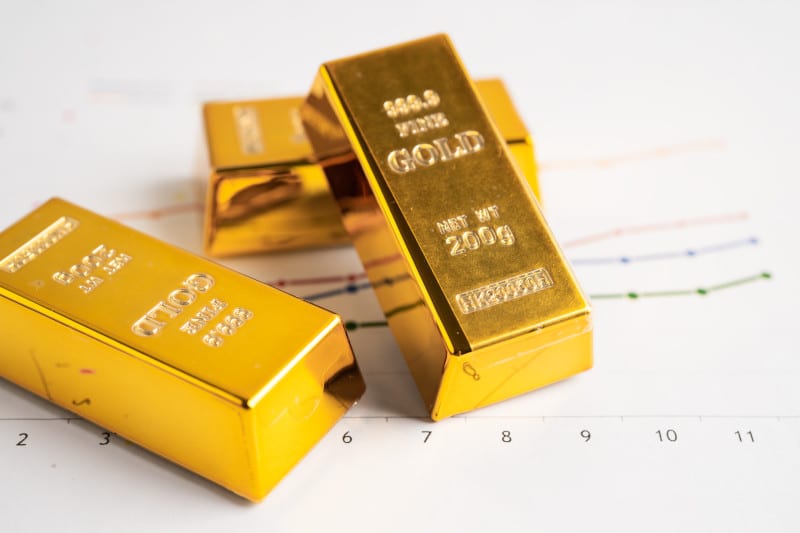
5 Steps to Set Up a Gold IRA
If you think a gold IRA might be a good choice for you, you’ll be happy to know that you can set up a gold IRA in just five easy steps.
1. Choose Your Gold IRA Type
The type of self-directed gold IRA you set up may be dependent on how you want to fund your IRA. One of the most common ways to fund a gold IRA is through a rollover from an existing retirement account such as a 401(k), which would mean setting up a Traditional gold IRA so that you can use your existing pre-tax retirement savings.
If you’re transferring or rolling over funds from a Roth account, you will need to choose a Roth gold IRA. You can also open a Roth gold IRA if you want to do a Roth conversion.
2. Decide on Your Funding Source
The funding source for your gold IRA is dependent on what type of gold IRA you open. If you open a Traditional gold IRA, you can’t fund it with transfers or rollovers from Roth accounts such as a Roth IRA or Roth 401(k). But a Roth gold IRA can be funded with rollovers from pre-tax or Roth accounts.
Numerous types of retirement accounts can be used to fund a gold IRA, including 401(k), 403(b), TSP, and IRA accounts. You may want to check with your financial advisor or tax advisor before making a rollover to see if there are any tax implications, and to confirm that your current retirement accounts allow transfers or rollovers.
3. Choose Your Self-Directed Gold IRA Custodian
Like any other IRA assets, gold IRA assets need to be administered by a custodian per IRS regulations. Working with precious metals specialists, like those at Goldco, can help you find a custodian experienced with gold IRAs.
Once you have chosen your gold IRA custodian, you can open your gold IRA. When your gold IRA account is open, you can then start the rollover process.
4. Fund Your Self-Directed Gold IRA
Once you have opened your gold IRA, you can start the rollover process. Normally this is done by informing your plan administrator or IRA custodian of your rollover intentions.
Then you’ll sell assets in your current retirement account and roll them over into your gold IRA. Your current plan administrator or IRA custodian will normally be responsible for sending funds to your gold IRA custodian.
It can be very important to work with gold IRA specialists to make sure that the rollover process goes smoothly, that your funds end up where they’re supposed to, and that you’ve adhered to all IRS regulations. While the rollover process can be simple, if you make a mistake you may inadvertently open yourself up to tax liabilities or penalties.
After your funds have been rolled over to your gold IRA, you can then begin the process of determining which gold coins or gold bars you want to buy with those funds.
5. Select, Purchase, and Store Your Gold
Now that your self-directed gold IRA is funded, it’s time to choose which gold coins or gold bars you want to buy. Remember that certain types of gold coins aren’t eligible for IRAs.
That’s why it can help to work with partners like Goldco who offer IRA-eligible gold coins to ensure that you don’t expose yourself to taxes or penalties by inadvertently buying the wrong type of gold.
After you’ve purchased your gold coins or gold bars, they will be administered by your IRA custodian and stored at a bullion depository. This ensures that your gold is there when you need it.
Is a Gold IRA Right for You?
With fears of recession growing, more and more Americans are worried about their financial well-being. A gold IRA can be one method of helping to safeguard your retirement savings during these times of uncertainty.
The gold price has risen significantly over the past several months, setting all-time highs, and has been supported by safe haven buying. If the US economy were to falter, how much higher could the gold price go?
From its 2008 lows to its 2011 highs, gold nearly tripled in price. Could gold perform that way again during a future recession?
At Goldco we have worked with thousands of customers who want to benefit from gold’s potential price gains. Whether you want to start a gold IRA or just buy a few gold coins, we have gold coin and bar options available for any budget.
If you would like to learn more about our gold products, or about the gold IRA rollover process, contact one of Goldco’s precious metals specialists today. It’s never too late to start learning how to safeguard your savings with gold.




